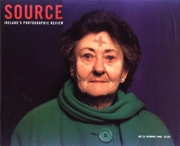Remnants of The Conflict
'Disputed Territory' by Anthony Haughey was at the Galerie Bodo Niemann, Berlin, January 23rd - February 27th, 1999
Review by Andrea Lange
Issue 19 Summer 1999
View Contents ▸
In the small space of the gallery I am surrounded by Anthony Haughey's large, square-format colour photographs. They were taken during the recent armistice, and show the no man's land between the borders of the Republic of Ireland and Northern Ireland. Bombed Bridge, Fermanagh / Cavan Border
Bombed Bridge, Fermanagh / Cavan Border
Although I have never been to Ireland there is a phalanx of 'Irish' images in my head: on the one side the advertising industry's trope of green hills and red-haired youngsters on folk music record sleeves and on the posters sticking to the building site fences all over Berlin, announcing slide shows about Ireland which are ever so popular with the Germans. On the other side there is the movie and media coverage of the 'Troubles' with its often sensational imagery of brutal shootings, exploding car bombs and snipers. And then there is an incident which enables a personal link to the feeling of unease emanating from Haughey's pictures. It is the memory of a telephone call to another Irish artist, Victor Sloan, living in Portadown, in the course of which a car bomb exploded nearby his house and within hearing distance. The shock of being witness to an event that appeared to be a slice of daily life - I would have thought it was part of an exaggerated and stereotyped notion of Northern Ireland as the site of a permanent threat of violence erupting out of the blue - is comparable to the shock of revelation when one starts to read and understand the particulars of Haughey's images of the border land.
At first glance they are just impressions of a pastoral landscape. There are no people in his photographs, but the traces they have left in this 'disputed territory' are telling. It is the small detail which is disturbing the seemingly tranquil scenery: the pieces of barbed wire amongst the greenery, the broken glass panes on the grass, the torn black rubbish bag draped around a wooden post like a flag. Yes, the landscape in his images is certainly green, but there are no blue skies with sunshine, it is not populated with smiling faces. Instead, it is scarred with the remnants of the conflict that raged over it, the atmosphere is definitely not friendly, but sinister and somber, charged with danger. Haughey's images oscillate between the two predominant perceptions of Ireland as tourist spot and as terror-ridden hell. His picture Bullet Hole in Telephone Kiosk combines these opposite views by literally overlayering them: we look onto an idyllic winding country road through the bullet-shattered window pane of a telephone booth at the road side. Bullet Hole in Telephone Kiosk, Co. Tyrone
Bullet Hole in Telephone Kiosk, Co. Tyrone
The Galerie Bodo Niemann, a gallery devoted to photography, is part of a large complex of buildings which have been extensively renovated after the reunification of the two German states. Situated in the East Berlin district called 'Mitte' ('Centre'), it is now indeed at the heart of Berlin, housing theatres, cinemas, restaurants and galleries behind its polished surfaces devoid of the shrapnel fissures still visible in a few facades of houses in neighbouring streets which have not been done up since the Second World War. And not too far away, next to the Reichstag, similar funeral wreaths as in Haughey's Memorial I (showing a wreath amongst some twigs) can be found, shaded by some trees, to commemorate the lives of people who were shot dead trying to cross the few yards of blank space between the two sides of the Berlin Wall into the West. Outside of Berlin, along the former border line, nature is doing its best to overgrow the cleared stripes breaking up the landscape.
Other articles mentioning Anthony Haughey:
Other articles on photography from the 'Documentary' category ▸






